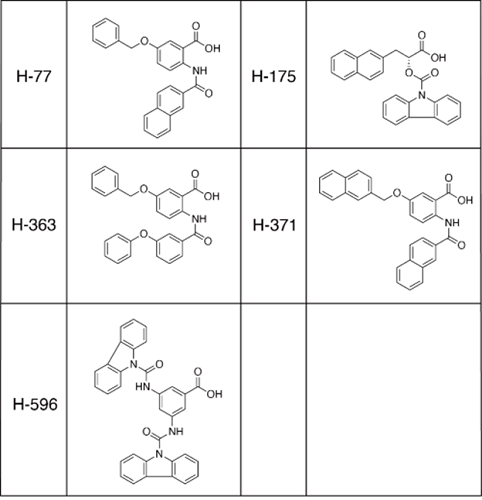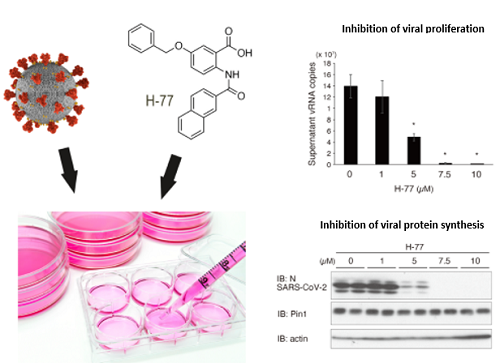Key points of the research results
- Currently, there are no commercially available drugs to treat novel coronavirus infections that are easy to take and work specifically against the virus.
- We have discovered that Pin1 (※1), a type of proline isomerase (※2) found in cells of the body, is indispensable for the propagation of the novel coronavirus.
- Furthermore, we found that our newly developed Pin1 inhibitory compounds strongly inhibit the propagation of the novel coronavirus. We are now improving the compounds to develop new therapeutic agents against coronavirus infections.
Outline
Professor Tomoichiro Asano (Department of Medical Chemistry) and Professor Takemasa Sakaguchi (Department of Virology) at the Graduate School of Medical Sciences, Hiroshima University have revealed that a proline isomerase enzyme called Pin1 present in infected cells is essential for the propagation of the novel coronavirus, based on experiments in which the expression of Pin1 was suppressed.
In collaboration with Professor Takayoshi Okabe (The University of Tokyo) and Professor Hisanaka Ito (Tokyo University of Pharmacy and Life Sciences), they added novel Pin1 inhibitors to cells infected with the novel coronavirus and found that it strongly suppressed the growth of the virus. The antiviral effect of the new Pin1 inhibitor was also observed when the compound was added after the cells were infected with the virus. The results strongly suggest that Pin1 inhibitors may be a potential therapeutic agent for the treatment of COVID-19 infections.
This research was supported by the AMED Research Program for Promotion of Innovative Drugs for Emerging and Re-emerging Infectious Diseases under the title "Development of therapeutic agents for new coronavirus infections (COVID-19) using Pin1 inhibitor compounds" (Representative: Professor Tomoichiro Asano), and the research results will be published online in the American academic journal Scientific Reports at 10:00 a.m. on September 17 (18:00 JST on September 17, 2021).
Announcement details
[Background]
Novel coronavirus infections, which have been spreading since early 2020, have become not only a serious medical and health threat in countries around the world but also a major obstacle to a wide range of community activities, including economic ones. Although several vaccines have been developed and the percentage of vaccinated people is increasing, the number of infected people is still increasing, making it difficult for people to resume economic activities. Furthermore, the emergence of more infectious mutant strains that escape immunity is continually occurring, making it impossible to contain this infectious disease with vaccines alone.
Therefore, in addition to vaccines, it is widely recognized that there is a need for therapeutic agents that can be used after infection with novel coronaviruses.
[Details of Research Results]
It has previously been reported that Pin1, one of the families of proline isomerase enzymes, is involved in the promotion of several types of viral replication. In obese individuals, Pin1 expression is increased in various organs, and at the same time, these individuals are known to be more susceptible to severe COVID-19 infections.
To investigate the relationship between Pin1 and the propagation of the novel coronavirus, the research group first deleted Pin1 in Vero cells (※3) and then infected them with the novel coronavirus. As a result, they found that the virus could almost completely unable to proliferate in the cells.
They then selected compounds that inhibited the proliferation of the new coronavirus from among the roughly 600 small-molecule compounds that they newly developed as Pin1 inhibitors and obtained five compounds with strong antiviral activity (Fig. 1). With these compounds, they conducted experiments in which the Vero cells were treated with the compounds and infected with the new coronavirus, and as before, virus replication was almost completely inhibited (Fig. 2).
Furthermore, they found that the Pin1 inhibitors could inhibit viral replication even when added 6 hours after the infection of Vero cells with the new coronavirus. The results suggest that the Pin1 inhibitor blocks the process of viral replication in the cell after the virus has entered the cell.
[Future developments]
In the future, there are plans to optimize the Pin1 inhibitor used in the paper by chemical modification to develop a compound that inhibits the replication of the new coronavirus at lower concentrations that are less likely to cause side effects. The development of the Pin1 inhibitor is being carried out in collaboration with the University of Tokyo's Drug Discovery Initiative and the Tokyo University of Pharmacy and Life Sciences, to quickly advance from animal experiments to clinical trials and eventually achieve a successful therapeutic drug for the treatment of COVID-19 infections.
Reference data
Figure 1: Five compounds with strong inhibitory activity against the novel coronavirus, showing their chemical structures
Figure 2: When cultured cells are infected with the novel coronavirus and treated with H-77, one of the Pin1 inhibitor compounds, viral replication and viral protein synthesis are inhibited when the concentration of H-77 is high (7.5 µM, 10 µM).
Glossary of Terms
(※1) Pin1
Prolyl isomerase 1, is a proline isomerase that converts the cis and trans structural orientations of proline amino acids in a protein carrying a [-phosphoserine-proline-] or [-phosphothreonine-proline-] sequence motif. Although Pin1 is not essential for life since mice lacking Pin1 are born and grow normally, Pin1-deficient mice develop osteoporosis, weight loss, testicular atrophy, germ cell loss, skin atrophy, and breast atrophy in old age.
(※2) Proline isomerases
Of the 20 amino acids that make up proteins, only proline’s peptide bond can form cis or trans structural isomers. In the body’s cells, proline isomerase enzymes convert the isomers between cis and trans, and Pin1 is one member of this enzyme family.
(※3) Vero cells
Vero cells are cultured cells derived from the kidney epithelium of the African green monkey. Vero cells are widely used throughout the world, and are typically employed in the evaluation of toxins produced by E. coli (verotoxin) and for the culture of viruses. The cells used in this study are specifically VeroE6/TMPRSS cells, in which the TMPRSS2 gene was introduced into the subline E6 of Vero cells so that it is stably expressed, which increases the efficiency of infection by the novel coronavirus.
Article publication information
- Journal: Scientific Reports
- Title of paper: Prolyl isomerase Pin1 plays an essential role in SARS‐CoV‐2 proliferation, indicating its possibility as a novel therapeutic target .
- Author(s): Takeshi Yamamotoya1, Yusuke Nakatsu1, Machi Kanna1, Shun Hasei1, Yukino Ohata1, Jeffrey Encinas2, Hisanaka Ito3, Takayoshi Okabe4, Tomoichiro Asano1*, Takemasa Sakaguchi5
1. Department of Medical Chemistry, Graduate School of Biomedical and Health Sciences, Hiroshima University
2. Anenti Therapeutics Japan, Inc.
3. School of Life Sciences, Tokyo University of Pharmacy and Life Sciences
4. Drug Discovery Initiative, The University of Tokyo
5. Department of Virology, Graduate School of Biomedical and Health Sciences, Hiroshima University
*Corresponding Author
- DOI: 10.1038/s41598-021-97972-3
Media Contact
Inquiries on the study
Graduate School of Biomedical and Health Sciences, Hiroshima University
Department of Medical Chemistry, Professor Tomoichiro Asano
TEL: 082-257-5135
E-mail: tasano*hiroshima-u.ac.jp
Department of Virology, Professor Takemasa Sakaguchi
Phone: 082-257-5157
E-mail: tsaka*hiroshima-u.ac.jp
School of Life Sciences, Tokyo University of Pharmacy and Life Science
Department of Bioorganic Chemistry, Professor Hisanaka Ito
TEL: 042-676-5473
E-mail: itohisa*toyaku.ac.jp
Press inquiries
Public Relations Group, Public Relations Department, Hiroshima University
TEL: 082-424-3701
E-mail: koho*office.hiroshima-u.ac.jp
Public Relations Division, General Affairs Department, Tokyo University of Pharmacy and Life Sciences
TEL: 042-676-6711
E-mail: kouhouka*toyaku.ac.jp
(Note: Please replace * with @)

 Home
Home





